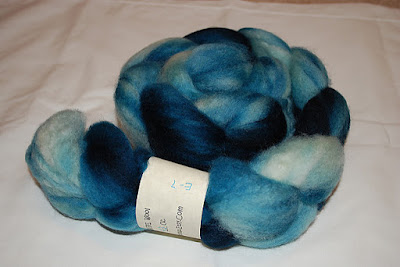The last time I did a Friday post, I shared how I felt in the dryer. I had such fun sharing that I thought I'd make Friday Fiber Fun an occasional series, and as I've posted every day this week, I figured I might as well make the week complete with a post today!
Today's fiber fun is my latest obsession: the scrappy marled hat. I've now finished four of these hats and don't feel bored of knitting them yet, so I imagine there will be still more to come from me. Knitting one of these hats isn't rocket science, especially if you've knit enough basic hats to be able to wing a beanie on your own, but I know not everyone is comfortable knitting without a pattern, and certainly the scrappy nature of these hats adds a level of complexity. So I'm going to give you my basic recipe below and also give you some tips to make knitting one of these hats easier and faster. These are great for charity knitting or when you're knitting for someone whose measurements you don't know.

The Scrappy Marled Hat: A Basic Recipe
To fit an average child (adult) head, with a bit of vertical slouch
Yarn: two strands of fingering, held together
Needles: US 4 (3.5 mm) and US 6 (4.0 mm), or sizes needed to obtain gauge
Gauge: 20 stitches and 30 rounds = 4 in./10 cm in stockinette stitch in the round
Notions: one stitch marker, yarn needle to weave in ends
With two strands of yarn held together and smaller needles, cast on 96 (104) stitches. Join to work in the round, being careful not to twist, and place marker to indicate beginning of round. Work in 2x2 ribbing (k2, p2) for 1 in./2.5 cm. Change to larger needles and work in stockinette stitch (knit all stitches) until hat measures 5.5 (6) in./14 (15) cm or desired length to start of crown.
Work crown decreases as follows:
Round 1: *K10 (11), k2tog; repeat from * to end -- 88 (96) sts.
Round 2 (and all even rounds): K.
Round 3: *K9 (10), k2tog; repeat from * to end -- 80 (88) sts.
Round 5: *K8 (9), k2tog; repeat from * to end -- 72 (80) sts.
Round 7: *K7 (8), k2tog; repeat from * to end -- 64 (72) sts.
Round 9: *K6 (7), k2tog; repeat from * to end -- 56 (64) sts.
Round 11: *K5 (6), k2tog; repeat from * to end -- 48 (56) sts.
Round 13: *K4 (5), k2tog; repeat from * to end -- 40 (48) sts.
Round 15: *K3 (4), k2tog; repeat from * to end -- 32 (40) sts.
Round 17: *K2 (3), k2tog; repeat from * to end -- 24 (32) sts.
Round 19: *K1 (2), k2tog; repeat from * to end -- 16 (24) sts.
Round 21: *K0 (1), k2tog; repeat from * to end -- 8 (16) sts. Child size ends here.
Round 23: (K2tog) around -- 8 sts.
Break yarn and thread it through 8 remaining stitches. Weave in ends on right side of fabric, then flip the hat inside out to show the reverse stockinette, or weave in ends on inside if you want your stockinette side to show. Block as desired.
Now, the tips!
First of all, if you're planning to flip the hat inside out and you want your cast-on edge to look the same, cast on using an alternating long-tail cast on. This video shows how to do it with a 1x1 rib. I do the same thing, but I cast on two stitches knitwise, then two stitches purlwise.
Next, an easy way to join your scraps: If you're using up lots of little bits of leftovers, you're going to end up with a lot of ends to deal with, and not many of us really likes weaving in ends. So when I knit these hats, I join in new scraps using the clasped weft join. This is actually a technique used in weaving, but it comes in handy in knitting as well and it's a way to avoid having any extra ends to weave in. If you've ever done a Russian join, then this will seem similar to you, but it's much faster and easier. First, when you get to about the last foot of one of your strands, fold it back on itself and place the end between your needles and poking out at you:

You'll now continue to knit a few more stitches, but now you'll be holding three strands together rather than two (don't worry, the extra bulk is totally not noticeable in the knit fabric). When you have just a small loop of the double yarn left, thread the new yarn through it and double it back on itself in the opposite direction:
Continue to knit, holding all the strands together. When the tail of the new strand pokes out, you can just trim it off (I recommend trimming off all the ends after blocking). If you'd like to see a video of this join, here is one showing it in the context of a sock using a single strand of yarn, but the method is exactly the same here. Using this join as you add in new scraps means that when you finish, the only ends you actually have to weave in are from the cast on and bind off.
Finally, the same methods used here can be used for an easy cowl! Do the ribbing, work in stockinette until it's about an inch shorter than the total desired length, do another inch of ribbing, and bind off -- easy peasy!
I hope these basic instructions and tips will help you look at your scraps in a new way!













































